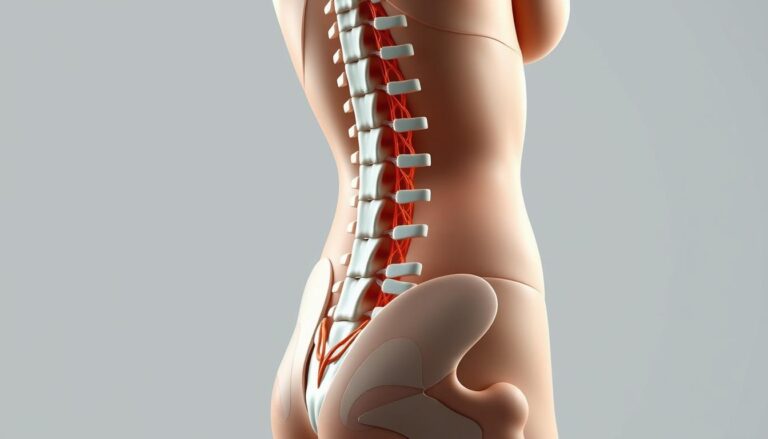How to Get Rid of a Stiff Neck in 10 Seconds
Neck pain is a common issue, affecting nearly one in three people. It often stems from muscle strain, poor posture, or excessive time spent hunched over a phone. A small, precise movement can swiftly alleviate neck pain, preventing it from ruining your day.
Making gentle movements can enhance blood flow to tight muscles, reducing inflammation. Applying heat or cold can expedite this process. Ice helps to calm swelling, while heat relaxes muscle fibers. Over-the-counter pain relievers like ibuprofen or acetaminophen can also provide relief. Additionally, topical gels offer targeted pain management.
Key Takeaways
- Micro-movements can deliver instant stiff neck relief without special tools.
- Alternate heat and cold for about 10–20 minutes depending on acute vs. chronic tightness.
- Try OTC NSAIDs or topical analgesics for short-term fast neck pain relief when needed.
- Fix posture: keep the screen at eye level and roll shoulders down to reduce strain.
- If pain lasts over a week, radiates, or causes weakness, seek medical care.
how to get rid of a stiff neck in 10 seconds
The quickest fix often feels almost too simple. A single, slow head tilt paired with a gentle chin tuck held for ten seconds can ease a tight neck. This micro-stretch boosts local blood flow and reduces muscle spasm. It targets the tight bands that form from tech neck and poor posture, offering quick stiff neck relief when tension flares up.
Quick Micro-Stretch To Try Immediately
Sit or stand tall with your shoulders relaxed. Gently tuck your chin toward your chest as if nodding “yes” very slightly. Hold that tucked position for a calm count of ten. Breathe normally and keep the motion slow. Release with care and repeat once or twice if it feels good.
Chin tucks and neck retraction are proven neck pain relief techniques for correcting forward head posture. They work whether seated at a desk or standing by a sink. A single 10-second hold often gives instant easing and can be paired with heat, cold, or a short self-massage for added benefit.
Stop the move if it causes sharp pain, spreading arm numbness, or dizziness. Avoid this micro-stretch after recent major trauma or when a clinician has advised against neck movement. If home methods fail, consult a health care provider or a spine team such as specialists at Aurora Health Care.
| Step | Action | Why It Helps |
|---|---|---|
| 1 | Sit or stand with a straight back | Aligns the cervical spine so the stretch targets the right muscles |
| 2 | Gently tuck the chin and tilt head slightly down | Shortens overactive neck extensors and eases muscle spasm |
| 3 | Hold for 10 seconds, breathe slowly | Increases local blood flow and provides quick stiff neck relief |
| 4 | Release slowly and reassess comfort | Prevents sudden strain and gauges if further action is needed |
Instant Stiff Neck Relief Techniques For Immediate Easing
Neck tension can flare without warning. Quick, targeted steps often ease pain within minutes and guide recovery over the next hours. Below are practical approaches that blend simple tools and gentle touch for instant stiff neck relief.
Heat And Cold Applications You Can Do Fast
For a new strain or sharp pain, use ice for 10–15 minutes to curb inflammation. Wrap a bag of frozen peas or an ice pack in a thin towel. Repeat every hour as needed in the first 24 hours.
When stiffness feels long-standing or tight, apply heat for 15–20 minutes. A warm shower or an electric heating pad soothes muscles and improves flexibility. Short, repeated cycles of heat and cold for about 20 minutes each can boost circulation and speed recovery.
Place topical analgesics like lidocaine patches or menthol creams under heat or cold to increase local effect. Keep applications brief to avoid skin irritation. For acute pain, favor ice; for chronic tightness, choose heat.
Micro-Massage Moves To Release Tension
Micro-massage for neck uses small, focused strokes to relax knots without heavy pressure. Start with fingertips at the base of the skull and stroke downward toward the shoulders. Work in short sets of 30–60 seconds.
A tennis ball pressed against a wall offers targeted pressure on tight spots. Hold steady pressure for 30–90 seconds, then roll slowly along the trapezius for 1–2 minutes. Avoid direct pressure over swollen or bony areas.
After warming the muscles, massage toward the heart to increase blood flow. Tools such as handheld massagers or a wrapped heating pad complement finger work. If tightness persists, consider a licensed massage therapist or physical therapist for deeper treatment.
| Technique | When To Use | Duration | Key Tip |
|---|---|---|---|
| Ice Pack | Recent strain or sharp pain | 10–15 minutes, repeat hourly | Wrap in cloth to protect skin |
| Heat Pack / Warm Shower | Chronic tightness and stiffness | 15–20 minutes | Soften muscles before massage |
| Contrast (Heat + Cold) | Boost circulation during recovery | 20 minutes each, several times daily | Short cycles, monitor skin response |
| Micro-Massage For Neck | Localized knots and tender spots | 30–120 seconds per spot | Use light strokes toward heart |
| Tennis Ball Against Wall | Trigger points in trapezius | 1–2 minutes rolling | Apply steady, gentle pressure |
| Topical Analgesics | When extra local relief is needed | As directed on product label | Combine with heat or cold for added effect |
Neck Stretches For Stiffness You Can Do At Your Desk
Short breaks at a desk can prevent stiffness from setting in. Try simple moves that fit into a meeting or coffee pause. These quick routines improve circulation and ease tension without changing clothes or leaving the chair.
Simple, Office-Friendly Stretches
Start with chin tucks: sit tall, pull the chin straight back, hold for a second, repeat 10 times. Chin tucks correct forward head posture and set a neutral spine.
Next, do side-tilt stretches. Drop your ear toward each shoulder and hold 5–10 seconds. Use fingertips at the temple for a gentle assist if needed. These ease lateral tightness common after long typing sessions.
Include neck rotation stretches by turning the head slowly to each side. Hold each turn 15–30 seconds and breathe steadily. Move smoothly and stop if sharp pain appears.
Add seated shoulder rolls and gentle neck retraction to round out the set. These office neck stretches fit into short breaks and require no equipment.
How Often And How Long
Micro-breaks work best. Take a brief stretch every 30–60 minutes when possible. If your schedule is tighter, aim for every 1–2 hours instead.
Do 1–3 reps per stretch during each break rather than a long single session. Short, frequent practice keeps muscles loose and reduces the risk of tech neck on long workdays.
Standing or a short walk between sets magnifies benefits. Pair these neck stretches for stiffness with monitor adjustments—screen at eye level and a neutral spine—to prolong relief.
Stiff Neck Remedies That Provide Fast Relief
When a neck locks up, quick choices matter. Short-term relief often blends over-the-counter meds with simple hands-on steps. This mix helps ease pain, reduce guarding, and make stretches more effective.
Over-The-Counter Options And When To Use Them
For many strains, nonprescription NSAIDs for neck pain such as ibuprofen (Advil, Motrin) or naproxen (Aleve) cut inflammation and dull the ache. Follow label dosing and watch for warnings about stomach upset, blood pressure, or kidney problems.
Acetaminophen (Tylenol) can ease pain when NSAIDs are not suitable. Topical analgesics neck products — gels, creams, and patches from brands like Voltaren or Salonpas — provide targeted relief with fewer systemic effects.
Use medication for short flares or while starting heat, ice, and gentle stretches. Stop and seek care if pain lasts more than a week or if numbness, weakness, or balance issues appear.
Non-Drug Remedies To Combine With Medication
Heat and cold work well alongside pills and creams. Apply ice for 10–15 minutes after a sudden strain, then switch to heat to loosen tight muscles. These simple steps boost the impact of topical analgesics neck applications.
Brief self-massage, rolling a tennis ball against the upper back, and easy neck stretches reduce muscle guarding. Small posture fixes while sitting and short walk breaks help circulation and speed recovery.
Keep an eye on interactions and risks when using NSAIDs for neck pain repeatedly. If medical conditions like ulcers or chronic kidney disease exist, consult a clinician before ongoing use.
- Fast plan: NSAID or acetaminophen as appropriate, topical analgesic for local relief, heat after 48 hours, daily gentle stretching.
- When to pause: Worsening symptoms, new numbness, fever, or pain beyond seven days—seek professional assessment.
Exercises For Stiff Neck Muscles To Prevent Recurrence
Strengthening the neck and upper back helps prevent future stiffness. Regularly doing a few targeted exercises boosts endurance. This makes everyday activities less straining on tight neck muscles.
Begin with gentle isometrics. Do chin tucks for 10–15 reps, holding each for 3–5 seconds. Then, move to neck resistance presses by pushing gently against the forehead or head for 5–10 seconds. These exercises help control sudden movements.
Shoulder blade squeezes are also essential. Hold each squeeze for 15–30 seconds, repeat 3–4 times. Add rows with a light band or dumbbells to strengthen the upper back. This combination shifts the load from tight neck muscles.
How To Progress Safely
Start with low resistance and short holds. If you feel mild soreness, increase reps before adding weight. Gradually move to light band resistance and then to controlled concentric exercises like rows and shrugs.
Always watch for symptoms. If exercises cause pain, numbness, or weakness, stop and seek medical advice. Physical therapy can offer personalized progressions and adjust techniques as strength increases.
- Chin tucks: 10–15 reps, 3–5 second holds.
- Neck resistance presses: 3 sets of 5–10 second holds.
- Shoulder blade squeezes: hold 15–30 seconds, 3–4 reps.
- Banded rows: 2–3 sets of 8–12 reps for upper back endurance.
Perform these exercises daily or every other day, depending on soreness. Combine strength exercises with mobility drills to maintain gains and reduce pain.
Postural Changes And Ergonomic Fixes To Reduce Neck Strain
The neck is quick to respond to our habits. Making small adjustments in posture can significantly reduce muscle pressure and prevent chronic pain. These changes, combined with ergonomic solutions, make everyday activities more comfortable.
Immediate Posture Corrections
Adjust screens to eye level to maintain a straight gaze. Holding phones and tablets at eye height prevents the forward head tilt common in tech use.
Roll your shoulders down and back. Ensure your head is aligned over your shoulders, avoiding the forward lean. Sit with feet flat on the floor and maintain a neutral spine.
Integrate these adjustments into your daily routine. Set a timer to check your posture every hour. Take a deep breath and adjust your posture before returning to work.
Workspace Setup Recommendations
Use an external keyboard and mouse with a laptop stand or monitor riser. Position the top third of the screen at eye level and the keyboard close to avoid reaching forward.
Choose a chair with lumbar support. Adjust the seat height so your knees are at roughly 90 degrees. Rest your forearms lightly on armrests while keeping your shoulders relaxed.
- Place the mouse within easy reach to stop overreaching.
- Alternate sitting with standing breaks every 30 to 45 minutes.
- Pair ergonomic fixes for neck strain with upper-back strengthening to sustain posture gains.
Natural Remedies For Stiff Neck That Complement Stretches
Small daily habits can significantly improve neck comfort. A blend of good sleep, regular movement, mindful breathing, and simple lifestyle choices supports long-term relief. This makes targeted stretches more effective.
Hydration, Sleep, And Lifestyle Factors
Water keeps spinal discs and muscles flexible. Aim for consistent fluid intake throughout the day. This is crucial for maintaining hydration and neck health, especially when sitting for extended periods.
Choose a sleep pillow that supports the neck. Memory-foam or cervical pillows maintain cervical curves and reduce morning stiffness. Avoid sleeping on your stomach, as it can twist the neck and undo the benefits gained during the day.
Regular movement is key. Incorporate short walks, gentle aerobic exercises, and strength training sessions into your routine. These activities improve circulation and posture. Also, carry less weight in shoulder bags and maintain a healthy body weight to reduce mechanical strain on the neck.
Stress Management And Relaxation
Mental tension can tighten neck muscles. Short breathing exercises can calm the nervous system and reduce muscle guarding. Try box breathing for 60 seconds between tasks.
Progressive muscle relaxation and brief mindfulness breaks can help lower chronic tightness. Apply heat, massage, or topical rubs after relaxation to extend the benefits and enhance the effectiveness of stretches.
- Use heat packs for five to ten minutes before stretching to loosen muscles.
- Schedule micro-breaks: stand, roll shoulders, take three deep breaths every 40–60 minutes.
- Quit smoking to protect discs and speed tissue recovery.
When Quick Fixes Aren’t Enough: Signs To See A Health Care Provider
The body sends signals when a sore neck needs more than rest and ice. If simple measures fail or symptoms grow worse, timely evaluation can prevent complications and restore function.
Warning Signs That Need Medical Attention
Seek care if neck pain lasts more than a week despite home treatment. Persistent pain that interferes with sleep, work, or daily tasks should not be ignored.
Watch for neck pain red flags such as severe pain after a fall or car crash. Pain that shoots into the shoulder, arm, or hand, along with numbness, tingling, or weakness, suggests nerve involvement.
Other urgent red flags include loss of coordination, trouble walking, fever with stiffness, sudden nausea, or light sensitivity. These symptoms can indicate infection or neurological issues and require prompt assessment.
What A Clinician May Offer
A clinician begins with history and physical exam to pinpoint the cause. Treatment often starts with tailored physical therapy and targeted exercises to rebuild strength and mobility.
Prescription medications for pain or inflammation may be used when over-the-counter options fall short. If exam findings suggest structural problems or nerve compression, imaging for neck pain such as X-ray or MRI helps guide care.
An orthopedist or spine specialist can recommend injections or surgical options in rare, refractory cases. Referrals and a clear plan help patients move from pain to recovery with less guesswork.
| Problem Noticed | Likely Action | Why It Matters |
|---|---|---|
| Ongoing pain >7 days | Primary care visit, PT referral | Prevents chronic stiffness and loss of function |
| Pain after trauma | Urgent imaging for neck pain, urgent consult | Detects fractures or ligament injury early |
| Radiating arm pain or numbness | Neurological exam, MRI if needed | Identifies nerve compression that may need intervention |
| Fever, severe headache, light sensitivity | Immediate evaluation, possible hospital workup | Rules out infection like meningitis |
| Progressive weakness or coordination loss | Specialist referral, advanced imaging | Protects function and guides timely treatment |
Fast Neck Pain Relief Routines You Can Adopt Daily
Daily micro-routines can effectively reduce neck tension with minimal effort. These short, focused exercises enhance blood flow and flexibility. They don’t require a gym or special equipment. These habits can be incorporated into your morning routine, coffee breaks, or between meetings.
Sample 2-Minute Routine For Mornings And Work Breaks
Adopt a 2-minute neck routine that can be done multiple times a day. Begin with 30 seconds of gentle chin tucks—about ten slow reps—to align the head with the spine.
Then, spend 30 seconds on side-tilt holds, 15 seconds on each side, while breathing steadily. This helps relax tight muscles. Follow with 30 seconds of shoulder rolls, matching your breath, to further ease tension. Finish with 30 seconds of self-massage or a warm compress to release any remaining knots.
Repeat this routine two to four times daily for quick relief from neck pain and a smoother start to your day.
How Routine Prevents Recurring Stiffness
Short, frequent movements are more effective than one long stretch. Regular activity prevents muscle guarding and reduces stiffness.
Integrate the 2-minute neck routine with posture checks, staying hydrated, and ergonomic adjustments at your desk. Over time, your range of motion will improve, and the risk of stiffness will decrease.
If you notice a slowdown in progress, consider consulting a physical therapist. They can create a tailored plan to address specific weaknesses and posture issues. This will enhance the effectiveness of your routine in preventing recurring stiffness.
Conclusion
Quick fixes can often alleviate pain swiftly. A simple 10-second micro-stretch, which includes a gentle head tilt and a subtle chin tuck, can be combined with brief heat or cold. Additionally, light self-massage can help answer the question of how to get rid of a stiff neck in 10 seconds. These actions ease tension and restore movement, allowing you to return to your activities without discomfort.
For sustained relief, incorporate these quick fixes into your routine. Make posture adjustments, perform short stretches regularly, and strengthen your neck and upper back. Ergonomic changes at your workspace, staying hydrated, and improving sleep quality are also crucial for long-term neck pain management. While over-the-counter remedies and topical treatments can offer temporary relief, they are most effective when combined with non-drug stiff neck remedies like physical activity.
If symptoms persist, worsen, or include numbness, weakness, or radiating pain after trauma, seek medical attention. Healthcare professionals can provide imaging, physical therapy, prescription medications, or specialist referrals to prevent further complications. By implementing quick interventions and consistent self-care, most individuals can maintain their neck’s mobility and resilience over time.
FAQ
How To Get Rid Of A Stiff Neck In 10 Seconds?
A simple 10-second stretch can offer quick relief. Sit or stand upright, then slowly lower your chin toward your chest while tilting your head slightly down. Hold this position for 10 seconds before releasing. This action helps counteract forward-head posture and boosts blood flow, providing instant relief from a stiff neck.
What Is A Quick Micro-Stretch To Try Immediately?
Try a controlled chin tuck with a slight head tilt. Hold for 3–10 seconds, or do a single 10-second hold. Keep your spine straight and shoulders relaxed. Repeat this stretch once or twice. Adding brief heat or cold can enhance the effect.
Which Heat And Cold Applications Provide Instant Stiff Neck Relief?
For recent strains, apply ice for 10–15 minutes to reduce inflammation. For chronic tightness, use heat (such as a warm shower or heating pad) for 15–20 minutes to relax muscles. Alternating between cold and heat in short sessions can improve circulation and speed recovery.
What Micro-Massage Moves Help Release Tension Quickly?
After warming the area, use your fingertips to glide from the base of the skull down the trapezius toward the heart in gentle strokes. A tennis ball pressed against a wall can target tight spots. Roll it slowly for 1–2 minutes. Avoid deep, aggressive kneading over bony areas or swollen tissue.
What Neck Stretches For Stiffness Can I Do At My Desk?
At your desk, perform chin tucks (10 reps), side-tilt holds (5–10 seconds per side), and slow neck rotations (15–30 seconds each side). Shoulder rolls and brief neck retractions are also beneficial. Keep movements slow and pain-free, doing short sets frequently rather than long sessions.
How Often And How Long Should I Do Desk Stretches?
Take micro-breaks every 30–60 minutes when possible. Do 1–3 reps per stretch multiple times a day. Stretch holds of 5–30 seconds, depending on the move, are typical. Progress gradually.
Which Stiff Neck Remedies Provide Fast Relief?
Fast relief comes from a 10-second micro-stretch, heat or ice packs, brief self-massage, and over-the-counter medications like ibuprofen, naproxen, or acetaminophen. Topical analgesic gels or patches also offer localized relief. Combining these methods can yield better results.
When Should I Use Over-The-Counter Medications?
Use OTC NSAIDs (ibuprofen, naproxen) or acetaminophen for short-term pain control when stretches and heat/cold don’t suffice. Always check the label and consult a doctor, especially with ulcers, kidney issues, or drug interactions.
What Non-Drug Remedies Work Best With Medication?
Pair medications with non-drug measures: posture corrections, heat/cold therapy, gentle massage, and targeted stretches. Hydration, brief walks, and ergonomic adjustments also reduce strain and speed recovery.
Which Exercises For Stiff Neck Muscles Prevent Recurrence?
Strengthening exercises include neck isometrics (resisted head presses), shoulder blade squeezes, shoulder shrugs, and rows. Start with short holds (5–10 seconds) and low resistance, progressing as tolerated. This enhances endurance and reduces future stiffness.
How Do I Progress Strengthening Safely?
Begin with isometrics and low-resistance bands, increase reps before resistance, and keep motions slow. If exercises provoke radiating pain, numbness, or weakness, stop and consult a clinician or physical therapist for tailored progression.
What Immediate Posture Corrections Reduce Neck Strain?
Raise screens to eye level, hold phones at eye height, and keep the head aligned over the shoulders. Roll shoulders down and back, and sit with a neutral spine and feet planted. These quick fixes cut forward-head stress and reduce tech neck tension.
What Workspace Setup Recommendations Help Neck Pain?
Use a monitor riser or laptop stand so the top of the screen is at eye level, and an external keyboard and mouse to avoid reaching. An ergonomic chair with lumbar support is also beneficial. Stand or walk briefly every 30–60 minutes. Small changes prevent chronic weakening and disc stress.
Which Natural Remedies Complement Stretches For A Stiff Neck?
Stay well hydrated (spinal discs need water), use a supportive pillow (memory foam or cervical style), and avoid stomach sleeping. Maintain a healthy weight and quit smoking to protect disc health. Regular aerobic exercise and flexibility work support long-term neck resilience.
How Does Stress Management Help Neck Pain?
Stress tightens neck muscles. Simple tools like deep breathing, short mindfulness breaks, progressive muscle relaxation, or journaling reduce muscle guarding. Combining these with heat or massage can provide faster relief.
What Are Warning Signs That Need Medical Attention?
Seek care if neck pain lasts more than a week despite self-care, follows trauma, or comes with radiating arm pain, numbness, weakness, loss of coordination, fever, severe headache, or light sensitivity. Stop home stretches if symptoms worsen or radiate.
What Might A Clinician Offer For Persistent Neck Pain?
Clinicians can provide physical therapy with individualized exercises, prescription pain or anti-inflammatory medication, and imaging (X-ray, MRI) if nerve or structural issues are suspected. They may also refer to spine or orthopedic specialists. In rare cases, injections or surgery might be considered.
What Is A Sample 2-Minute Routine For Mornings And Work Breaks?
Try 30 seconds of chin tucks (about 10 slow reps), 30 seconds of side-tilt holds (15 seconds each side), and 30 seconds of shoulder rolls with deep breaths. Add 30 seconds of gentle self-massage along the trapezius toward the heart. Repeat several times a day for fast neck pain relief.
How Does A Daily Routine Prevent Recurring Stiffness?
Short, frequent micro-routines increase circulation, restore mobility, and counteract postural load. Combined with ergonomic fixes, hydration, and strengthening, consistent practice reduces muscle guarding and lowers the chance of repeat flares.




